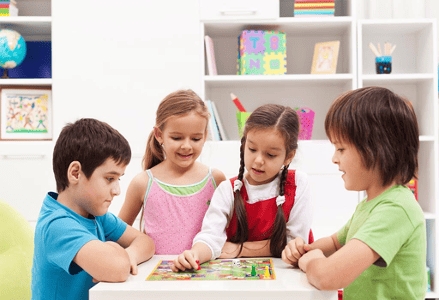
This is part of our series on board games by age. For more info check out our comprehensive guide to picking board games for kids.
Kids are never too young for board games! Games come in all shapes and sizes and are for all ages and abilities. They’re more accessible than ever before so there’s no excuse not to get your kids hooked asap. Not only will you always have someone to play board games with but your kids will benefit in so many ways from playing board games regularly.
In a child’s early years their brain is developing the fastest. The experiences they have will shape who they become and getting them to play games and be exposed to positive influences will have a positive impact on how their brain develops. The right board games can teach kids many useful skills such as cooperation and teamwork, problem solving, critical thinking, numeracy, maths and reasoning.
The best board games for young children will be easy to learn with minimal rules, encourage discussion and reasoning and have a short playtime to keep their attention. It’s been proven in studies that children prefer cooperative games over competitive games. Your toddler may not be playing Twilight Imperium with you anytime soon but here are some great board games now that will lay the foundation for more complex games in the future.
What are the Best Board Games for 3 Year Olds?
The Sneaky, Snacky Squirrel Game
Published by: Educational Insights Ages: 3+ Players: 2-4 Time: 15 mins
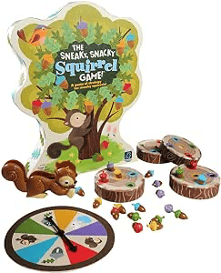
In this game, players set out to help squirrels forage for food and fill their log with delicious acorns. Players need to be wary, though, as other sneaky squirrels may try and steal acorns, or a strong wind could blow the whole stash away, forcing players to start all over again.
Players take turns spinning the spinner, which will dictate the action they need to take. They then use the squirrel squeezer (a pair of tongs shaped like a squirrel) to carry out the appropriate action. This normally involves using the squirrel squeezer to take one of the five different colored acorns and place it into their log. The first player to fill their log is the winner. The spinner has a space for each of the different colored acorns, as well as a few others that prompt players to take certain actions.
There are two blank acorn spaces that allow players to take one or two acorns of any color they need. There are two squirrel spaces, a sneaky squirrel that lets players steal an acorn from another player, and a sad squirrel that results in the active player skipping their turn. The final space is the squirrel storm, which if players are unfortunate enough to land on, results in all the players’ acorns being blown away, meaning they’ll have to start collecting all over again!
The game is really quick and simple to learn, with minimal rules and mechanics. For such a straightforward game, it teaches young kids a lot of skills. Some of the most prominent are color matching and sorting and the development of hand-eye coordination and fine motor skills through the use of the squirrel squeezer. There are also elements of strategic thinking and the development of interpersonal skills. The components provided are colorful, well-made, and visually appealing. This should provide plenty of fun for young ones.
We earn a commission if you make a
purchase, at no additional cost to you.
First Orchard
Published by: HABA Ages: 2+ Players: 1-4 Time: 10 mins

First Orchard is a beloved classic in the world of preschool board games and one of the best family board games for toddlers. It is designed for the littlest gamers to introduce them to the basic concepts of taking turns, recognizing colors, and practicing decision-making. Players work together, in this cooperative board game, to harvest fruit from the trees before a mischievous raven reaches the end of the path.
The gameplay is straightforward: on their turn, a player rolls a color die and picks a piece of fruit of the corresponding color from the tree and places it in the shared basket. Rolling the raven prompts players to move the raven one space closer to the orchard. The cooperative nature of the game ensures that players cheer each other on to collect all the fruit before the raven arrives.
The beautifully crafted wooden pieces are perfect for small hands to grab and help with fine motor skill development. First Orchard not only provides toddlers with their first taste of structured play but also nurtures social skills and early game-playing etiquette. With each play, children learn the importance of teamwork and the joy of collective success.
Read our Full review of First Orchard here.
We earn a commission if you make a
purchase, at no additional cost to you.
Disney Eye Found It!
Published by: Wonder Forge Ages: 4+ Players: 1-6 Time: 30 mins
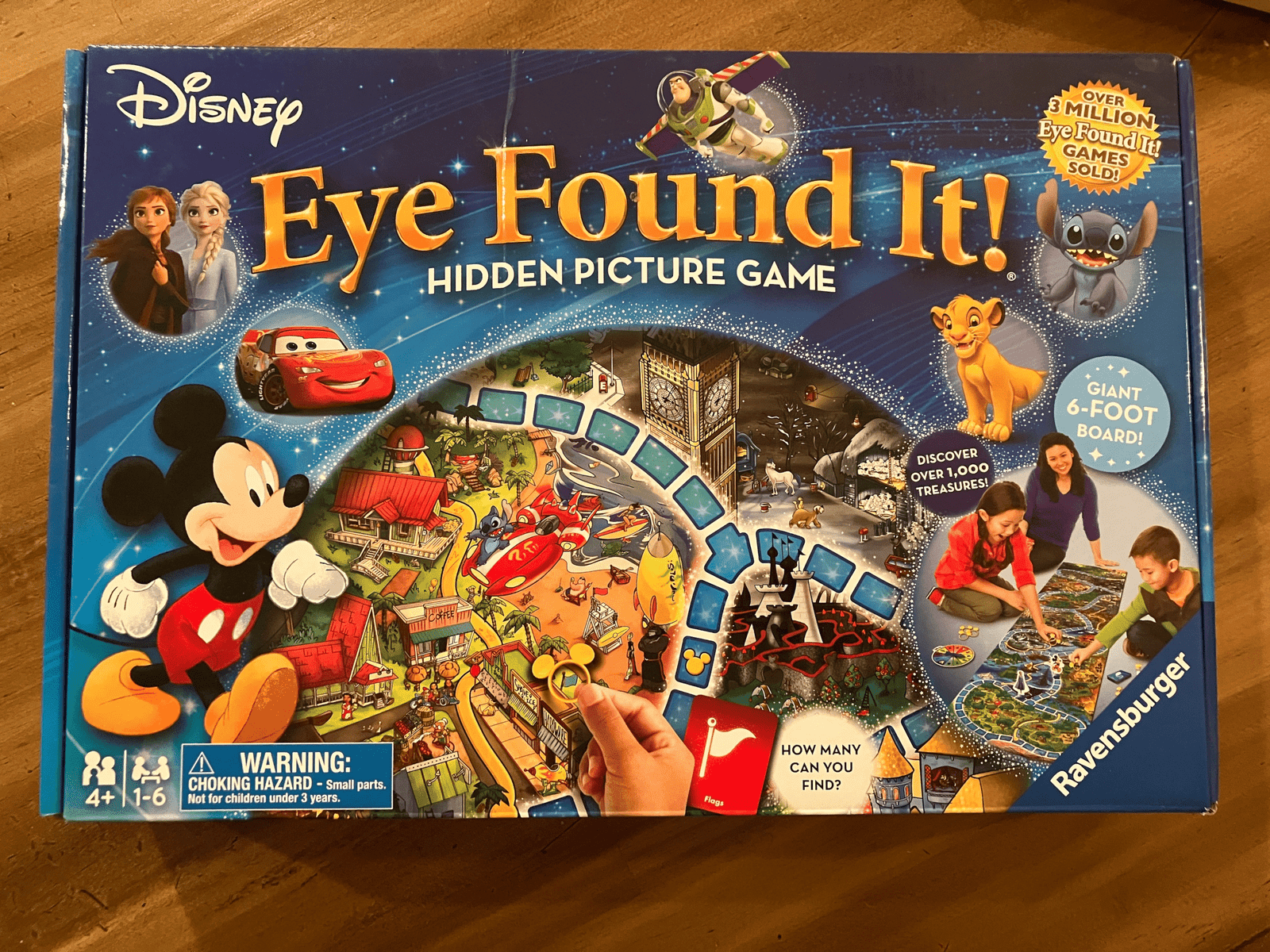
Disney Eye Found It! is a cooperative board game that encourages players to work together to find hidden items in the colorful, whimsical world of Disney. This game is perfect for younger kids, especially those who have a fondness for Disney characters and storytelling.
During play, players roll the dice and move along the winding path through various Disney realms, searching for iconic items and characters hidden on the massive six-foot game board. Every card drawn directs the players to search for a specific item, and everyone must try to find as many as they can before time runs out.
As a side benefit, this game helps children with object identification and matching skills, reinforcing their memory and observation capabilities. The social interaction encouraged by the cooperative gameplay teaches children to communicate effectively and to contribute to a group objective. The vibrant images and familiar characters keep the game engaging, offering a magical experience for Disney fans of all ages.
The unifying goal of finding items before the clock strikes makes for an experience filled with excitement and bursts of collective achievement. Disney Eye Found It! creates a magical playtime environment that celebrates discovery and teamwork among young friends and family members.
Read our full review of Eye Found It here.
We earn a commission if you make a
purchase, at no additional cost to you.
Candy Land
Published by: Hasbro Ages: 3+ Players: 2-4 Time: 30 mins
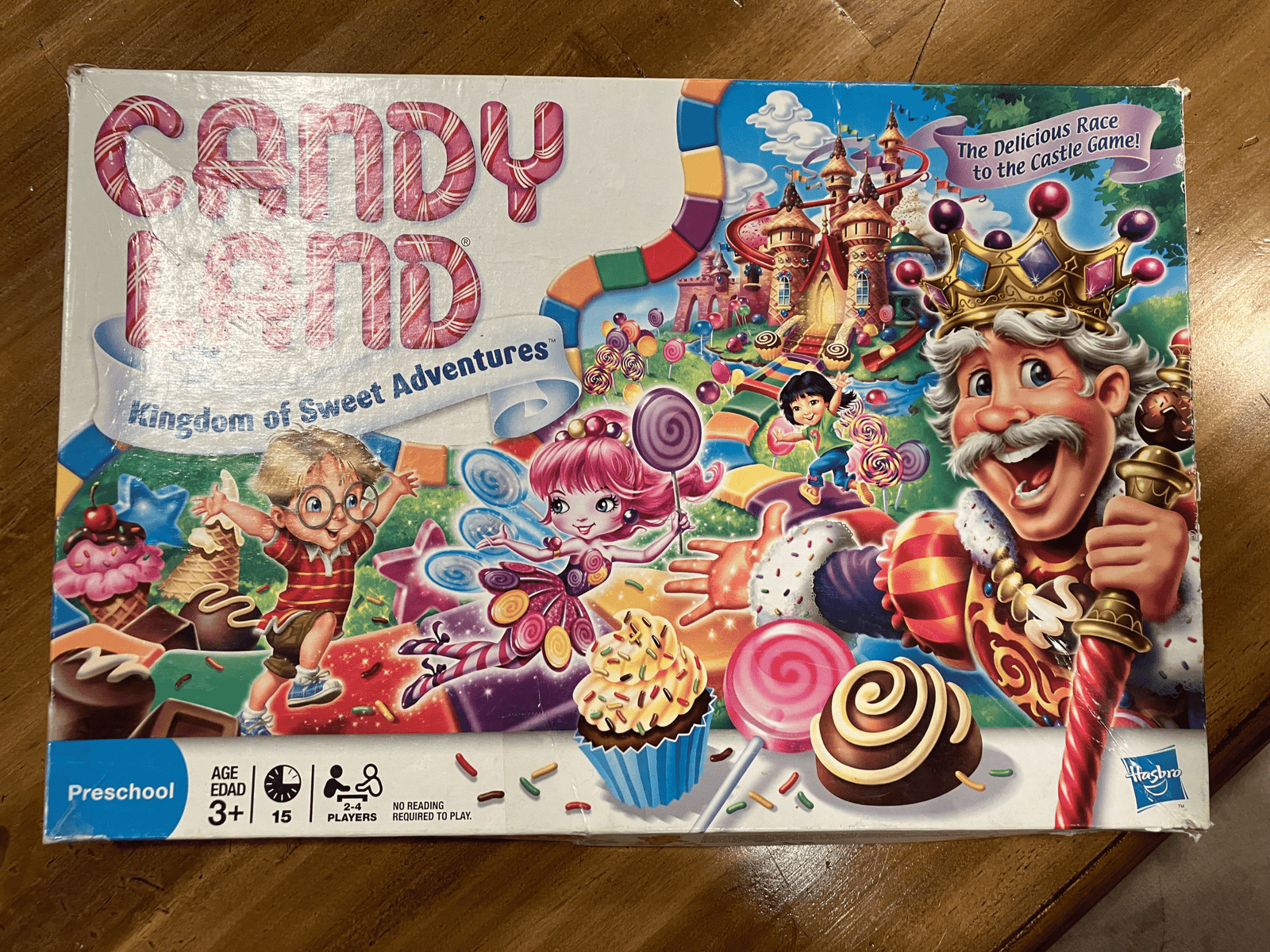
Love it or hate it, Candy Land belongs on any list of board games for 3 year olds because it truly is a classic game for younger children and serves as a fun introduction to family games. It is a colorful and straightforward board game that serves as an excellent introduction to the world of board gaming for young children. With no reading required, children can easily grasp the rules of silly game and enjoy the fantasy of exploring a land filled with sweets and characters like King Kandy and Gramma Nutt.
It’s a simple game with simple rules: players draw color-coded cards and move their pieces to the next matching color space. This teaches color recognition and matching while also introducing children to the concept of luck, as their progress is dependent on the cards they draw. There are also special cards that advance players to more attractive locations, such as Peppermint Forest and Gumdrop Mountains.
Children learn basic counting as they move their pieces from one space to the next and once they get the hang of it, this is one older preschoolers might even be able to play independently. Candy Land’s appeal lies in its whimsical board design and the dreamy promise of a candy-filled adventure, making it a timeless classic among preschool board games. It’s one of the best board games for young children to experience the structure and interaction of a board game and learn vital social skills such as taking turns and sportsmanship.
To be clear, this is not one of my favorite board games, but it’s a perfect game to use as a stepping stone and a great first board game that little kids love.
Read our full review of Candyland here.
We earn a commission if you make a
purchase, at no additional cost to you.
Animal Upon Animal
Published by: HABA Ages: 4+ Players: 2-4 Time: 15 mins

Animal Upon Animal is an enchanting stacking game that captivates children with its creative play and adorable wooden animal figures. Each player takes turns placing animals on top of an ever-growing and unsteady pile, trying not to let any animals tumble down. The animals come in various shapes and sizes, adding to the challenge of maintaining the balance of this precarious tower.
The aim is to be the first to successfully stack all your animals, thereby displaying dexterity, patience, and a steady hand. This game hones fine motor skills and develops a sense of spatial relationships, as players assess and select the optimal placement for each piece. It’s a great one for developing hand eye coordination. Moreover, it introduces children to basic principles of physics, such as gravity and balance, in a playful and accessible way.
With straightforward rules and quick gameplay, Animal Upon Animal encourages friendly competition and lots of laughs. The vibrant and high-quality wooden pieces are inviting and durable, ensuring that this game can be enjoyed time and time again as a family favorite. It’s an exemplary game for engaging young minds (and shouldn’t be underestimated in its appeal to different ages) and hands while fostering a love for tabletop gaming.
Read our full review of Animal Upon Animal here.
We earn a commission if you make a
purchase, at no additional cost to you.
Monza
Published by: HABA Ages: 5+ Players: 2-6 Time: 15-20 mins
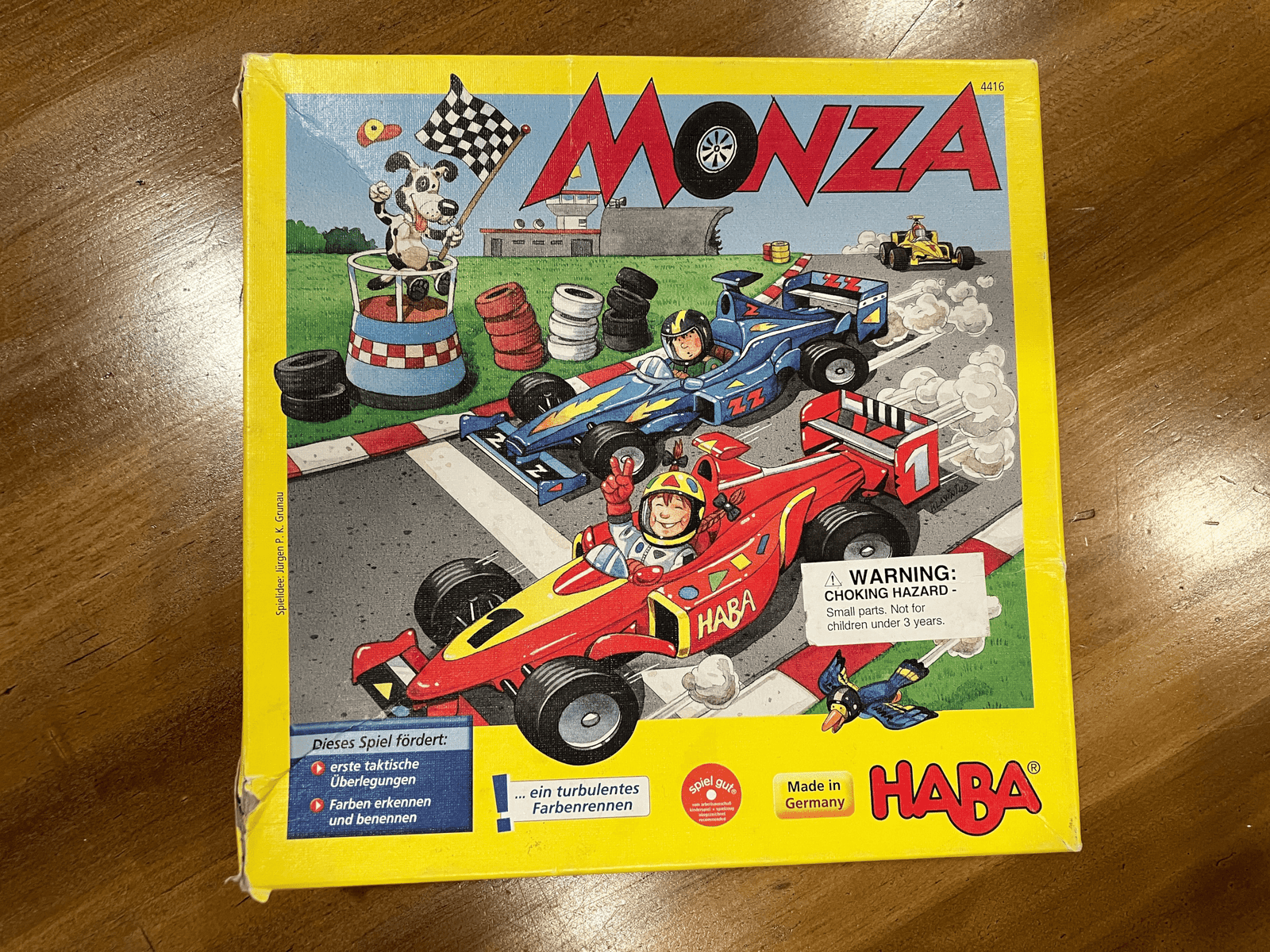
Monza is a thrilling race car board game designed for budding young gamers. It employs a simple color-based dice system that promotes strategic thinking while reinforcing color recognition and decision-making skills. Players each have a car on a track comprised of colored spaces, and they roll six dice with colors corresponding to the spaces on the track.
The objective is clear: maneuver your race car through the track by selecting the dice that match the next spaces. This challenges children to think ahead and plan their moves, improving their ability to strategize. What makes Monza stand out is its allowance for forward, diagonal, and side moves, thus introducing children to more complex movement patterns than most traditional linear track games.
The game’s playful design, featuring a vibrantly colored race track and wooden car tokens, captures the excitement of a motor race. As players navigate the race track, they also learn the basic mechanics of gameplay such as taking turns and abiding by game rules. Monza is a fantastic first step for children who are ready to graduate from simplistic preschool games to those that require more critical thinking and planning, and also works well for older kids.
Read our full review of Monza here.
We earn a commission if you make a
purchase, at no additional cost to you.
Snug As A Bug In A Rug
Published by: Peaceable Kingdoms Ages: 3+ Players: 2-4 Time: 15 minutes
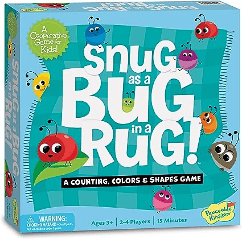
Bugs love playing under rugs! Help the colorful bugs get snug under the rug before three stink bugs show up and make a big stink.
Snug as a Bug by Peaceable Kingdoms is a cooperative game where players work together to try and get every bug under the rug before the stink bugs show up. At the start of the game, all the colorful bugs are placed on the board which serves as the rug. Players will roll the dice and spin the spinner to determine which bug they need to hunt for. Both dice and spinner will indicate whether players need to look for a bug that matches the color, pattern, or eye shape. If the player finds a matching bug they place it underneath the board with its head poking out. If they are unable to find one, they must place a grey stinkbug on the board. If all three make their way onto the rug, the game is over.
There are three different difficulty levels depending on the degree of challenge players need. Players can search by one attribute (color, for example) all game, switch attributes each turn, or look for two attributes on one bug (eye shape and pattern) for the hardest level of difficulty. This allows for children to test their skills and as they gain more confidence they can challenge themselves by adding more mechanics to the gameplay.
This is a great, quick game for kids and teaches them about color and shape matching, working together, and helps refine social development skills. Fast paced, simple to learn and full of colorful components to capture children’s imagination, Snug as a Bug will provide plenty of fun and enjoyment for little ones.
We earn a commission if you make a
purchase, at no additional cost to you.
Sequence For Kids
Published by: Goliath Games Ages: 3+ Players: 2-4 Time: 15 minutes
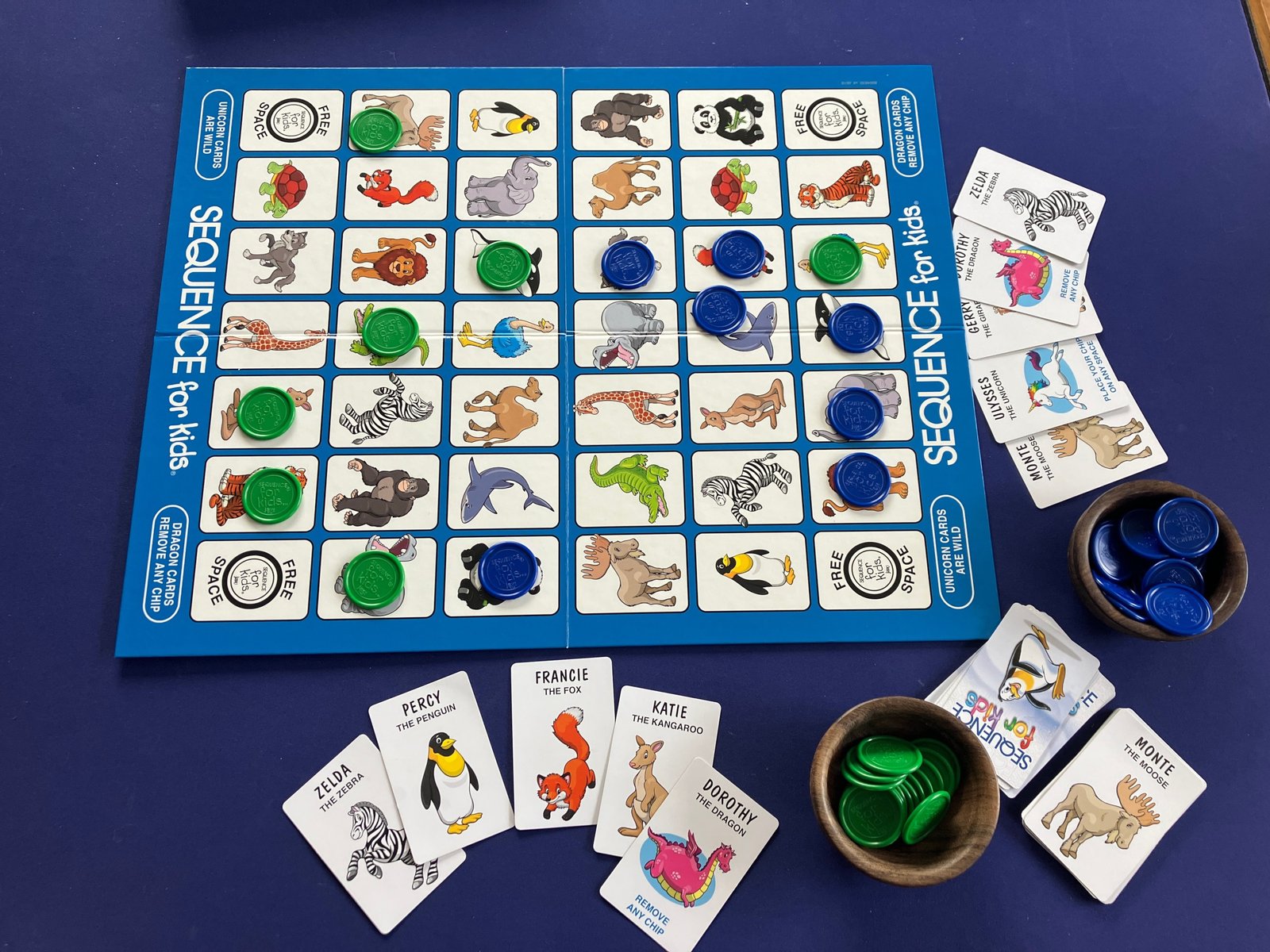
Match animal cards to spaces on the game board and get a sequence of four in a row to win! Sequence Junior is the child-friendly iteration of the original strategic game, offering a more approachable and visually stimulating version for children as young as three years old.
The goal in Sequence Junior is to place four tokens in a row, in any direction, by matching cards in the player’s hand to the corresponding space on the game board. The board has a 7X6 grid with each space representing one of the 19 different animals present in the game. Players take it in turns to place one of their cards down and a token on the corresponding space on the board. This continues until one player manages to get four tokens in a line and create a sequence.
The game presents a light element of strategy as players will not only try to create a sequence themselves but block other players from doing so also. This means players will need to think carefully about which cards they lay down, and when. Along with the free spaces in the corners, there are also two wildcards that don’t have a token represented on the board and come with their own rules. The unicorn allows a player to place a token anywhere and a dragon that allows one player to remove another’s token from the board.
Like most games on this list, Sequence Junior is light on rules but requires a slightly more strategic approach than the typical game aimed at older preschoolers. This doesn’t mean it’s a difficult game but does present it’s own challenge and requires forward thinking and planning in order to be successful. Playing with a grown-up is probably advisable as they can offer suggestions and support, but Sequence Junior offers a fun experience with it’s illustrated cards and elements of strategy.
Read of full review of Sequence For Kids here.
We earn a commission if you make a
purchase, at no additional cost to you.
Raccoon Rumpus
Published by: Educational Insights Ages: 3+ Players: 2-4 Time: 15 mins
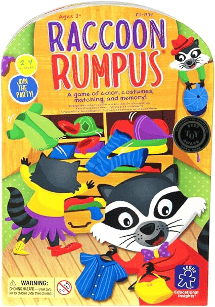
The Raccoons need help getting changed into their outfits for the day! Players will need to sort the variety of outfits and match them to their dice rolls in order to get the raccoons ready for the day.
In Raccoon Rumpus, players take a scantily clad Raccoon card and must roll a combination of dice to attempt to dress them in various different outfits. One die represents a color and one represents a type of clothing. In the default game mode, all outfits are placed up in the middle of everybody and easily accessible. When players roll their dice, they must find an outfit that matches both the color and type of clothing displayed on both dice. If they cannot then play moves on to the next player. Some faces of the die have special meanings; the rainbow lets players choose any color costume they want and the top and bottoms let players choose up to two outfits.
If a player rolls the underwear, however, they must remove all outfits from their Raccoon and start again! Whoever dressed their Raccoon in five different outfits first is the winner. There is a memory game variant to Raccoon Rumpus with slightly different rules and provides more of a challenge. Instead of placing the outfits face up they are placed facedown, and the clothing dice is removed. Players roll just the color dice, turn over a card, and if either part of the outfit matches the color on the dice then the player can take that outfit.
With its two different game modes, Raccoon Rumpus helps develop both color and attribute-matching skills and for those wanting an extra challenge, presents an extra element of difficulty with the memory variant. With interesting and colorful components, this is a fast-paced game that’s thoroughly enjoyable for younger gamers.
We earn a commission if you make a
purchase, at no additional cost to you.
Feed The Woozle
Published by: Peaceable Kingdoms Ages: 3+ Players: 2-5 Time: 15 mins
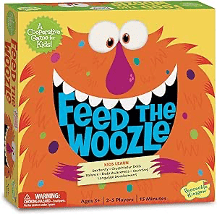
Hungry for chocolate-covered flies or hairy pickles? Well the Woozle is, and he’s hungry! Players work together and use their dexterity to attempt to feed them twelve different snacks before all the food is gone.
Feed the Woozle is an interactive game with three different levels of difficulty. The main object of the game is to transport snacks on a spoon to a Woozle standee about 8-10 feet away and place them in it’s open mouth. Players will roll a die to determine how many snacks they need to feed the Woozle. They’ll place them on the spoon and walk over to him. If any fall onto the floor they must stay there but for every snack successfully fed to the Woozle, players can take a “Yummy” card, to keep track of the score. If players can work together and feed twelve snacks to their furry friend then they win. If snacks run out before they can feed him twelve, the game is over.
This is the simplest variation of the game but there are more ways to play! The next level of difficulty incorporates a spinner into the game which dictates how the player must transport the snacks. After rolling the dice to determine how many snacks they’ll be taking, they’ll need to spin the spinner which will give them instructions such as “walk backward” or “bunny hop”. Needless to say, this can lead to hilarious results to add to the fun of the game! The hardest difficulty uses both dice and spinner, but players must also have their eyes closed on their turn feeding the Woozle. In this version, adult supervision is probably best in order to avoid any injuries!
Feed the Woozle is a fun game that gets kids active and off their seats to refine their motor skills, bodily awareness, and dexterity. Incorporating cooperative gameplay, players will cheer each other on and use teamwork to build up each other’s confidence. With three different modes of difficulty, it will provide something for everyone and keep kids busy and entertained!
We earn a commission if you make a
purchase, at no additional cost to you.
Conclusion
As you can see from the list above, most of these board games for 3 year olds incorporate cooperative elements, but all help to develop children’s skills in various different ways. Recognition of colors, shapes, and patterns is crucial for preparing them for school, working together helps promote and develop social interactions, and refining fine and gross motor skills will help them feel body confident. If you’ve played any great games that you enjoy playing with your little ones that you’ve found have helped them to grow and develop, we’d love to hear all about it!
Frequently Asked Questions (FAQ)
u003cstrongu003eWhat are the best indoor games for little ones?u003c/strongu003e
The games above, Sequence Junior, Raccoon Rumpus, and Feed The Woozle are great indoor games for little ones. They’re fun and good for cognitive and motor skills.
u003cstrongu003eDo I need to play these family board games with my child?u003c/strongu003e
While adult supervision or participation can enhance the game experience for younger players and help with rules and strategy some games are designed to be simple enough for children to play on their own. Games like Raccoon Rumpus have solo play variants but adult involvement is always a good idea to ensure safety and support.
u003cstrongu003eWill these fun games help my child for school?u003c/strongu003e
Yes many of these games will help with school readiness. They help with color recognition, shapes and patterns, maths skills and social interaction and teamwork skills all of which are important in a school setting.
u003cstrongu003eHow can I adapt these games for children of different skill levels?u003c/strongu003e
Many games including Feed The Woozle have different levels of difficulty that can be adjusted to the child or the whole family’s ability. You can also add house rules or modify existing ones to suit your child’s skill level.
u003cstrongu003eAre there cooperative games for children that involve fine motor skills?u003c/strongu003e
Feed The Woozle is a cooperative game that involves physical activity as children have to walk or hop to feed the Woozle. Other cooperative games may involve similar physical elements and get older kids moving and developing gross motor skills.
